
Newsletter of the Shell Club of Sydney
NSW Branch, The Malacological Society of Australasia Limited ACN 067 894 848
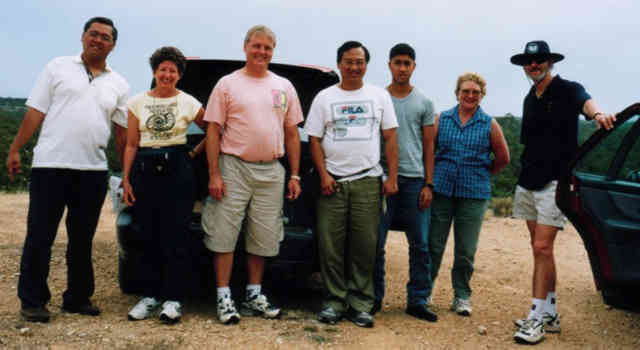
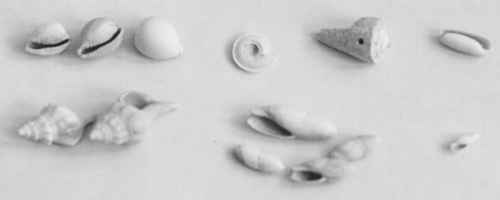
Field Trip at the last national Shell Show, Adelaide 2 years ago. Murbko Lens
Eng, Barbara Collins, Steve Dean and some of the 25 people that went on the fossil collecting day excursion.
News
Two of our members were affected by the Sydney fires. Patty was on the verge of evacuation, with fire engines in her street. Maureen lives west of Sydney in a street where most houses were destroyed. Theirs survived, but they did loose a garage, a car and had to release their farm animals.
October Club Shell Show
Steve Dean
Our club shell show in October went very well. There were multiple exhibits in every category, 26 exhibits in total. All were of very high quality, making judging difficult. We were given one of the leagues clubs larger meeting rooms for the show so there was plenty of room for the displays and for visitors. We even gained a new member. The room was lit exclusively with 'down light spots' creating a 'museum like' professional effect.
The club meeting and tea and coffee were conducted away from the displays in another part of the room. John Franklin ran a number of raffles with excellent prizes. Of special note were some excellent Fossils donated to our club by Barbara Collins of the Cairns Shell Club. Thank you Barbara. Barbara is a regular supporter of our club, and since she also deals in shells, we would encourage all to check out her shells for sale, to return the favour. There were also some lovely cones in the auctions. Most years our show runs at a loss. This year it made a significant profit. John worked very hard collecting display entry fees and running the raffles, door prizes etc. Thanks to Adrian and Steve for doing the rest of the work preparing the shell show.
This year shell of the show had to form part of an exhibit in one of the other catagories. Four members entered the shell of the show category and the scores were very close. Chris and Karen Barnes won with a large, dark coloured
Cypraea Chinensis live collected at Double Bay in Sydney. (This shell was featured in our may 2001
Sheller).
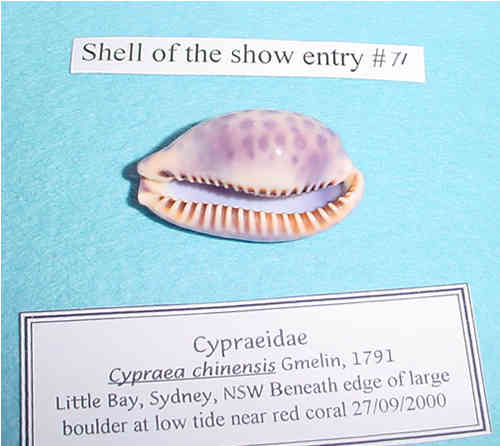
An unusual category, hard to judge and requiring unusual display was Micro Shells. Both exhibits were excellent and scored high marks. A small selection of the exhibits appear below - not necessarily the winning entries.
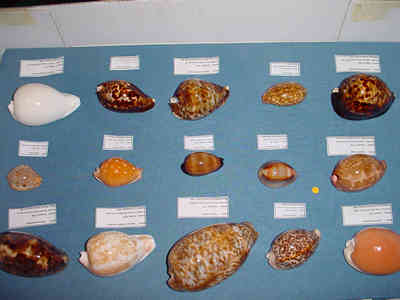
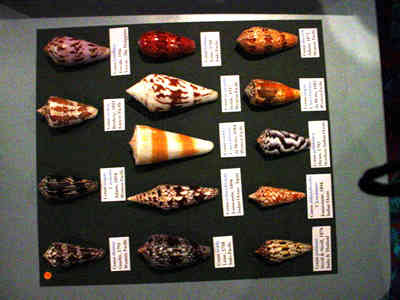
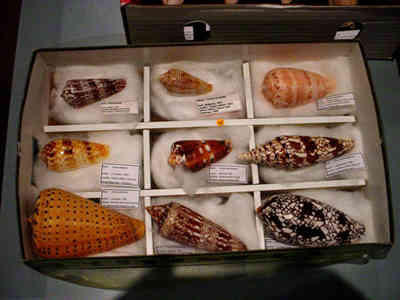
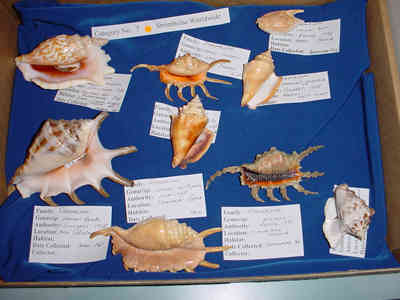
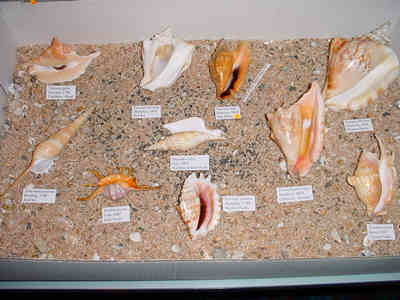
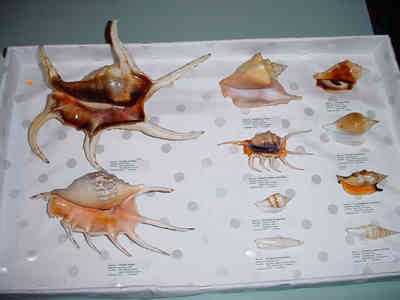
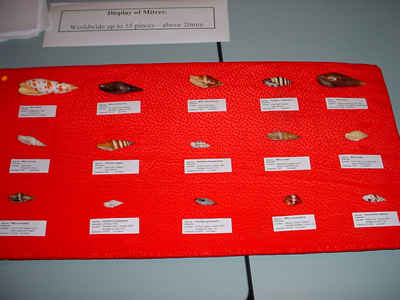 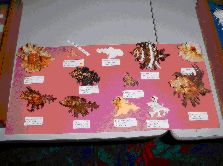
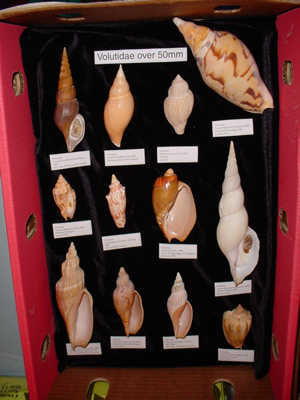 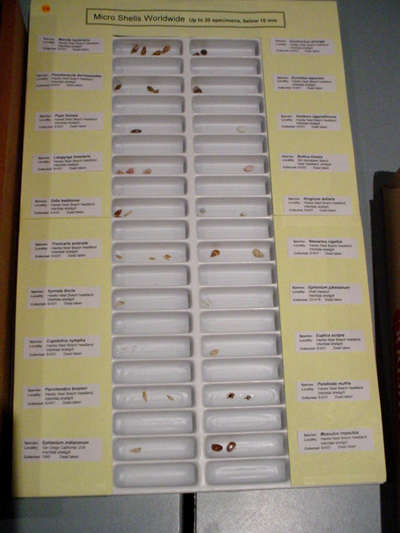
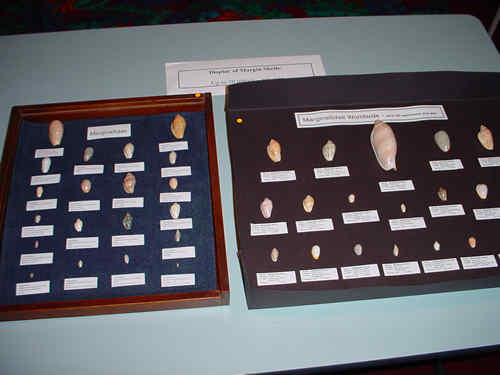
Other shell show results were as follows:
| Category |
First |
Second |
Third |
| Shells from one locality/Country |
Patty Jansen |
Peter Pienaar |
Chris & Karen Barnes |
| Marginellidae Worldwide |
Patty Jansen |
Steve Dean |
NA |
| Cypraea Worldwide < 50mm |
Chris & Karen Barnes |
Peter Pienaar |
John Franklin |
| Cypraea Worldwide > 50mm |
Chris & Karen Barnes |
Peter Pienaar |
John Franklin |
| Micro Shells Worldwide |
John Franklin |
Steve Dean |
NA |
| Mitridae Worldwide |
Steve Dean |
John Franklin |
NA |
| Strombidae Worldwide |
Adrian Brown |
Steve Dean |
John Franklin |
| Conidae Worldwide |
Adrian Brown |
Peter Pienaar |
John Franklin |
| Muricidae Worldwide |
Adrian Brown |
John Franklin |
NA |
| Volutidae |
Patty Jansen |
John Franklin |
NA |
December Club Field Trip - Norah Head
Steve Dean
The weather was good (sunny, not too windy) and the trip was well attended. Patty and her family, John Franklin and his family, Adrian and his mother and son, myself, my father and my son, Michael, Peter, Chris and Karen, my brother and his two shell collecting children, and Jack Hannan. (Sorry if I have left out anyone)
Adrian and myself arrived early and did a dive. There had been rough seas and the deeper water had low visibility due to grindings from rotting dead kelp, so we did not see many shells. When the others arrived the tide was not yet fully low, so collecting commenced out on the exposed rock platform in front of the lighthouse. My brother and his children stayed in this area longer than the others, snorkelling in rock pools, collecting on the platform and searching the grit on sandy beach patches to the South. They found a few species of cowries amongst other things. Everyone else headed North around the headland until they reached the rock pool. The rock platform in front of the rock pool, and indeed the break-wall that forms the rock pool are well sheltered and have good rocks to turn, as well as shallows with more rocks for snorkelling.
Under these rocks everyone found things that interested them, although nothing particularly rare.
Some of the species I picked up were:
- Turbo imperialis and Turbo torquatus in excellent condition with no growths and no spire wear, no doubt due to the sheltered location.
- An uncommon species Euchelus ampullus (Tate, 1893)
- Two good specimens of Morula nodulifera
- The Mitra carbonaria were fairly large and had no 'burn marks' or wear at the tip. Probably because the rock platform behind the rock pool and all the rock in the first 6M below low tide are completely covered with low dense weed.
- Good size, good condition Ranella australasia (which for some reason prove particularly difficult to remove all the animal and stop the smell.)
- Cypraea xanthodon, Cypraea clandestina, Cypraea caputserpentis, Cypraea erosa,
- Some larger than normal Umbraculum umbraculum
- A variety of bivalves attached to the underside of turnable rocks
- Two nice dead Haliotis rubra with backs in excellent condition, and insides in reasonable condition
- The live Granata imbricata were lighter coloured (almost albino) and with finer ribbing than specimens from around Sydney, may be it is a different species?
Michael found a live Conus anemone in good condition. It was VERY large for the area.
My eight-year-old Niece favours cones in her collection. She was very pleased when she found an excellent
Conus papilliferus fresh dead while she was snorkelling in the rock pool. The rock pool drains completely at low tide, but remains full of inquisitive children and tromping feet. I was therefore surprised at her find. I was even more surprised when
Hydatina physis appeared on the sand mid rock pool, and when someone successfully started pumping 'yabbies' in the same area of the pool.
The shells most prevalent on the platform were Haliotis coccoradiata
under rocks and Australium tentoriformis on top.
After the tide turned most shellers left, leaving only my family, my brothers family and my father - we have always believed you collect for the maximum time until the tide or weather lets you collect no more. With the incoming tide, large numbers of
Hydatina physis appeared crawling over the weed on the surface of the platform following the rising water. The
Cyprea caputserpentis became more prevalent exposed on the platform rather than under rocks. The children were best at spotting the
C. caputserpentis. (Possibly younger eyes, or more likely they are closer to the ground so they see under more ledges and cracks on the platform).
We did leave before dark.
Club Christmas Party
Most recent years the club Christmas party has taken the form of a field trip combined with a picnic. This year we did the field trip with picnic, but we also had a Christmas Dinner at the up-market restaurant at the same leagues club where we have our monthly meetings. Almost all of our Sydney members attended as well as many of their partners. We had 22 attendees around two tables. The three course ala-cart meals were excellent, and there were suggestions that we should move our monthly meetings to this restaurant all the time.
Michael seems to be a very regular raffle/lucky door prize winner. Our last meeting and this Christmas Party were no exception.
Four years ago at the National Shell Show in Sydney, during the formal dinner, one table started assembling and firing paper aeroplanes. Well with two tables at this dinner
and the same people at one table - you guessed it.
It was Patty and Maureen's birthdays, so we got the cellist who was providing the restaurant background music to play happy birthday.
Sitting at the paper plane manufacturing table there were also some budding artists, Carmel, Stephanie, Ashley and others. As the night continued, caricatures of shell club members started appearing on all sorts of scraps of
paper, primarily the back of the Bon-Bon joke slips. No one was spared. See if you can pick Ron, Des, Patty, Peter and other well-known club members in the pictures below.
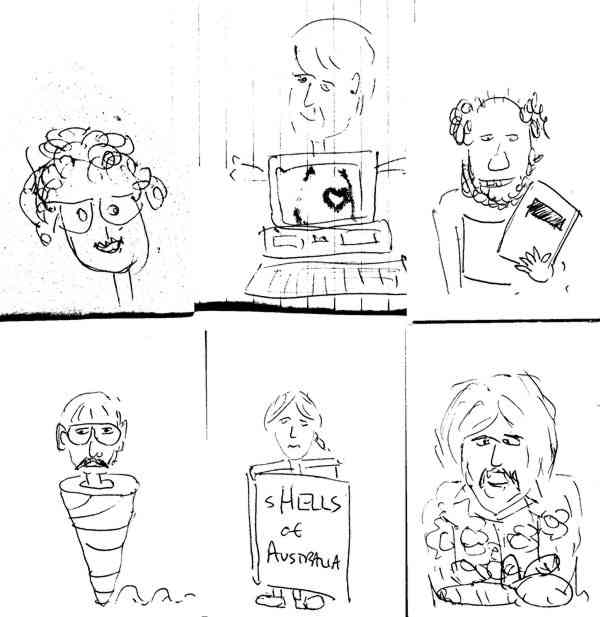
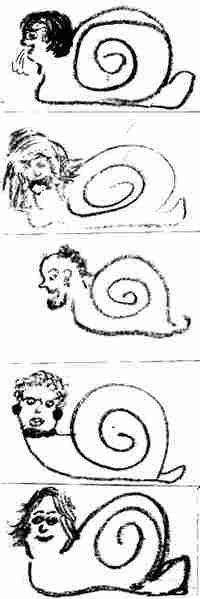
Murbko Shell Fossils
Steve Dean
Now that the National Shell Show in Brisbane is almost upon us, it is a good time to reminisce on one of the highlights of the last National Shell Show in Adelaide almost two years ago. (It is also the last suitable excuse for me to finally write this article)
The Adelaide club organised a fossil collecting field trip for the day after the show. It included stops at two fossil sites and general site seeing, finishing with a barbecue at Simon Barber's house. Although I am not really a fossil collector, it was the field trip that tipped the balance convincing me to go to Adelaide, and I was not disappointed.
On the filed trip we drove up the main highway towards Sydney. At the point where the highway crosses the Murray River the road cutting contained many exposed and easily accessible fossils. We were told there were many more lower on the cliff line beneath the bridge. There were many Echinoid species, along with fossil spines (see picture below).
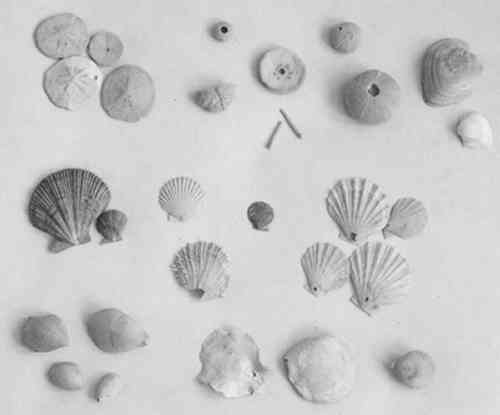
While Murbko had much more material and overall variety of intact specimens, at the cutting there was more variety of Pectinidae, more Brachiopods and larger Cypraeidae. We did not want to leave to go to Murbko, so we stopped at the cutting a second time on the way back to extract more Echinoids. The muddy sand that the fossils were in at the cutting was fairly hard. At Murbko it was soft sandy dirt requiring no tools to dig out the shells.
At both locations there were other types of fossil in other rock layers further up the cliffs, but these were harder to remove.
Murbko and the cutting are in the same Murray River gorge. They are about 20Km apart. The Murbko 'lens' is along a short dirt track through a farm. The 'lens' is a layer of sediment about 500m long and up to 15m high in the side of the cliff. Half way along there is a break due to a valley made by a creek that cuts down through the cliffs. This valley provides the method of access into the gorge. At the lens the cliff is sloping due to the softness of the fossil layer eroding out. All of it can be walked over. Most shell fossils had been exposed by weathering and could be picked up without any digging.
There were very many fossil shells to rummage through. By myself it would have taken two full days to look at all the exposed shells, let alone sifting through any of the loose sediment. With around thirty people we had given it a pretty good look over in one and a half hours. Some of the species I collected are shown in the following pictures, and you can see from the variety that collecting was relatively easy. We were told the layer we were looking in was 20 million years old. Some of the Turritellidae still had some of their colour. I wish my shells would retain their full colour for as long.
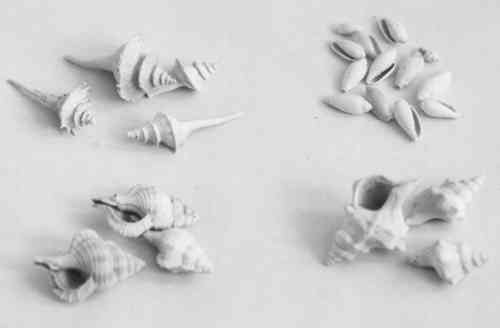
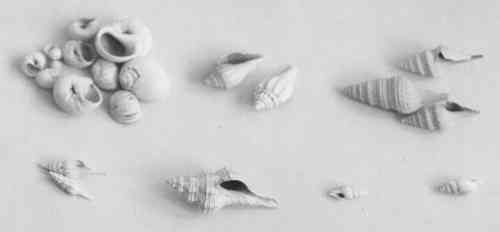
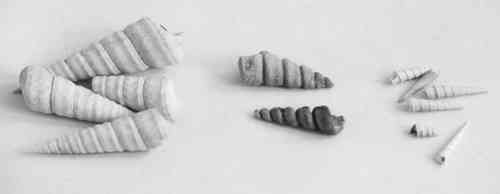
Turritellidae (left and right) Turritellidae fossil mud casts from inside the shells (centre)
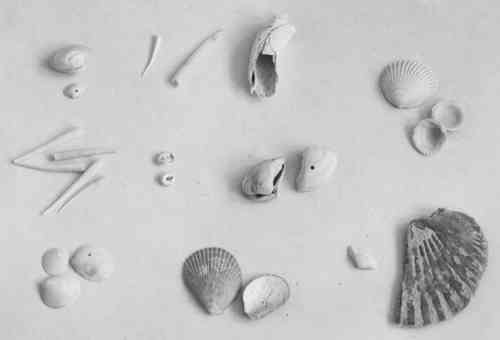
Interesting Mollusc finds from Sydney Harbour,
Botany Bay and Shoal Bay.
By Ashley Miskelly.
Here is a selection of photographs showing some beautiful mollusc specimens usually not encountered on shelling expeditions. The photographs have been taken with a macro lens, so some species may appear surrealistically large!
Below are bivalve Spondylus tenellus found subtidally at Vaucluse Bay, NSW. One specimen has managed to grow inside a broken glass jar, the other two were found encrusted with coralline algae and seaweed. The painstaking cleaning process has obviously paid off!

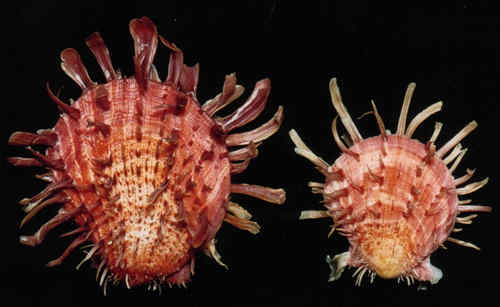

The bottle above shows another fascinating habitat for molluscs! There are five pairs of the bivalve Irus crenatus inside a sulphuric acid bottle. The shells grew in the bottle and cannot be removed because they have outgrown the diameter of the bottle neck. The bottle was found at low tide at Shoal Bay, NSW.
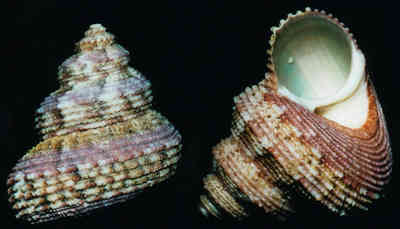 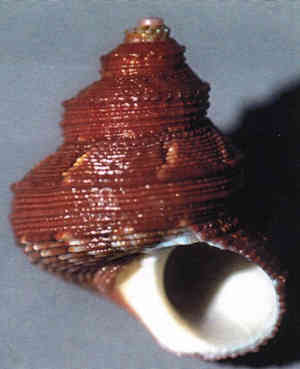
These two pictures are of Turbo exquisitus from Vaucluse Bay. This species is highly variable in colour and here we can see burgundy, lilac and light pink forms. The shell surface is intricately sculptured. This species is rare and lives subtidally. There is also a bright orange form. Most specimens found are inhabited by hermit crabs.
Below is a bivalve that is a favourite octopus delicacy. Acrosterigma reeveanum is a relatively common species, but these specimens were much richer in colour than most specimens. All of these came from Shoal Bay in shallow water from around octopus burrows.
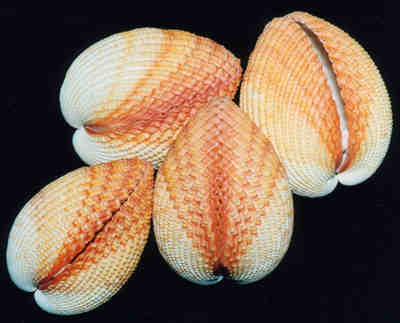
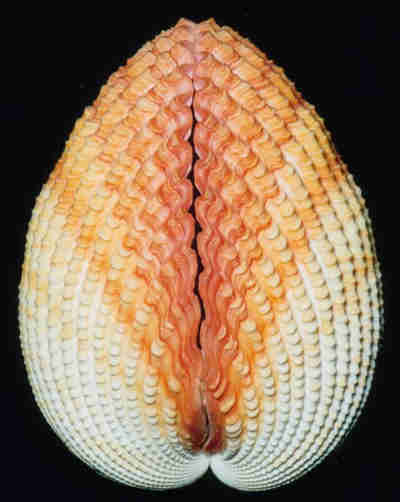
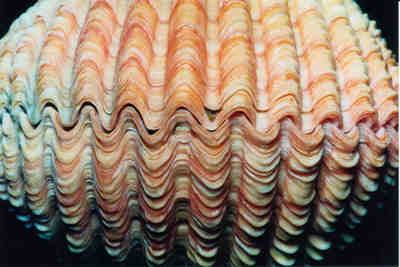
The Murex below is Chicoreus denudatus from Vaucluse. A fresh dead specimen with very long varices. Murex like this are usually found dead in piles of shells below low tide level.
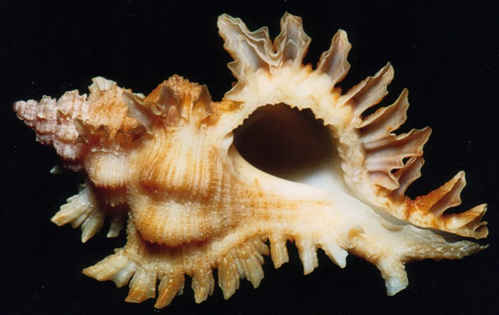
The photograph below that looks like a giant clam is actually an oyster no bigger than 2 inches across! This specimen is from Botany Bay.
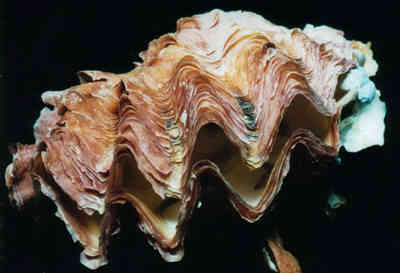
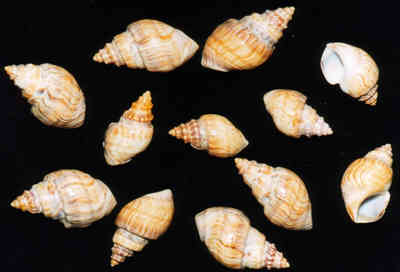
The above photograph shows a group of 12 Strutholariidae, part of the stromb family. The species is
Tylospira scutulata and yes, they were all collected live at Frenchman's Bay.
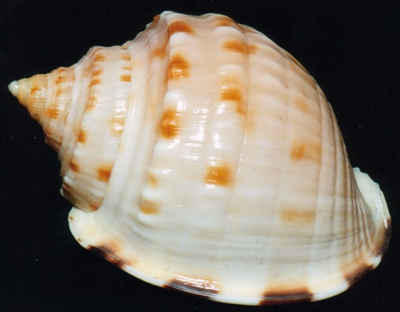
This is the helmet Cassis thompsoni, also from
Frenchman's Bay. This species does not usually
occur this far south, and it is a fine quality specimen
The final photo is a species of turrid found at a depth of 17m off Vaucluse.
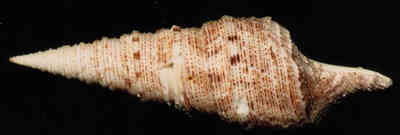
|


































